Family : Orchidaceae

Text © Prof. Pietro Pavone

English translation by Mario Beltramini
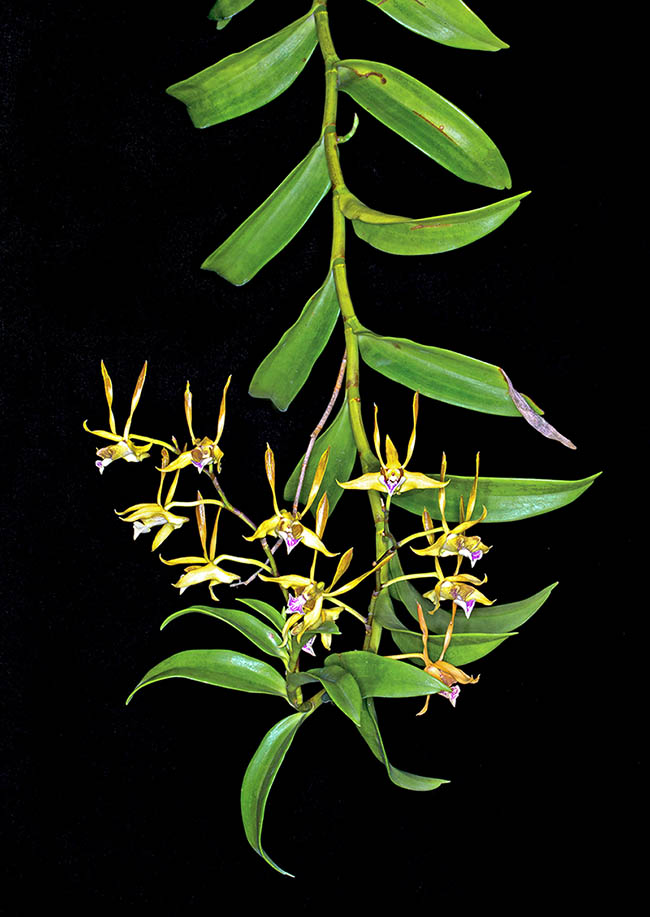
Dendrobium bicaudatum is an epiphyte, at times even lithophyte, native to Moluccas © Giuseppe Mazza
Dendrobium bicaudatum Reinw. ex Lindl. (1858) is a species native to the Maluku Islands (Sula, Seram and Ambon), Sulawesi and Philippines belonging to the family Orchidaceae, subfamily Epidendroideae, tribe Malaxideae, subtribe Dendrobiinae.
It is an epiphyte growing on the trunks and on the branches of the open forests, but also on the sunny rocks, from the sea level up to 1000 m of altitude.
The species was validly described by John Lindley (1799-1865) in J. Proc. Linn. Soc., Bot. 3:20 (1858) in the section Spatulata, upon drawings done by the botanist Caspar Georg Carl Reinwardt (1773-1854) founder, in 1817, of Bogor (Buitenzorg) Botanical Gardens in Java, where he collected and cultivated various species of plants of the surrounding islands (Maluku Islands, Timor and Sulawesi).
The name of the genus is the combination of the Greek substantives “δένδρον” (dendron), tree and “βίος” (bios), life, due to the several species of the genus that live on the trees getting their food from the humid atmosphere, typical to the equatorial forests.
The specific epithet is the combination of the Latin “bis”, twice, and “caudatum”, equipped with a tail, and refers to its long petals similar to two tails.
It is commonly known as the Two-tailed dendrobium.
Dendrobium bicaudatum presents numerous nodose pseudobulbs, strictly fusiform, similar to canes, slightly more enlarged in the median and basal part.
The stems, with circular sections, reach a length of 30 cm and a diameter of about 9 mm.
From the nodes of each pseudobulb form 4 to 10 leaves, up to 10 cm long and 2,5 cm broad, bifacial, somewhat coriaceous, sub-erect, lanceolate to strictly oblong-elliptic, bilobate.
In autumn and in winter, from the nodes of the apical portion of the stems, get form 4 to 8 10-20 long inflorescences, racemose, usually erect and with apparently fleshy axes bearing 4-5(8) flowers, with a diameter of about 5 cm.
The flowers are poorly fragrant and last up to 30-40 days. The petals, similar to antelope horns, take about seven days to fully elongate.
They are linear, spatulate, 2,8 cm long and 3 mm broad, brownish.
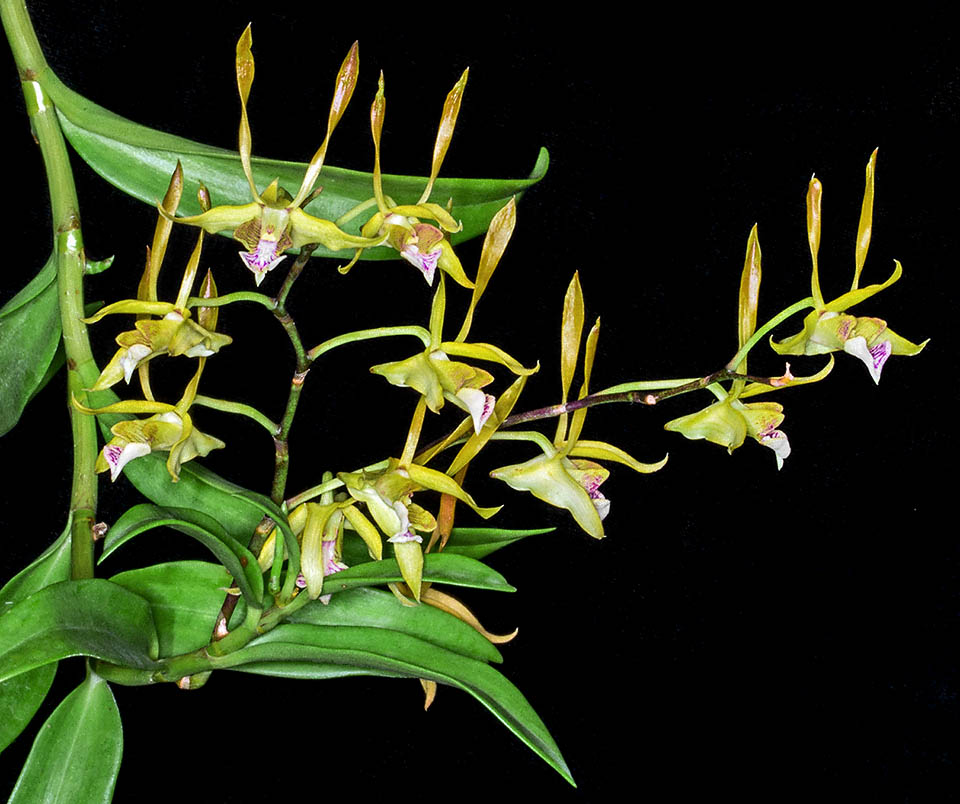
It has several nodose pseudobulbs similar to canes. The stems can be 30 cm long and the 10-20 cm racemose inflorescences carry even 8 flowers © Giuseppe Mazza
The dorsal and lateral sepals are green-yellowish. The dorsal sepal varies from triangular to ovate and is 1,6 cm long and 5,5 mm broad. The lateral sepals are triangular or falcate, 1,8 cm long and 8 mm broad. The labellum, 1,8 cm long and 1,4 cm broad, is white with reddish transversal veins, trilobate, narrowed at the apex, with triangular lateral lobes and median oval lobe.
Dendrobium bicaudatum distinguishes from the other species of Dendrobium of the same section Spatulata due to the dorsoventral leaves, the tubular sheaths, the median lobe of the labellum wider than long and the 7-9 mm long spur (mentum) formed by the labellum and by the foot of the column that is up to 7 mm long.
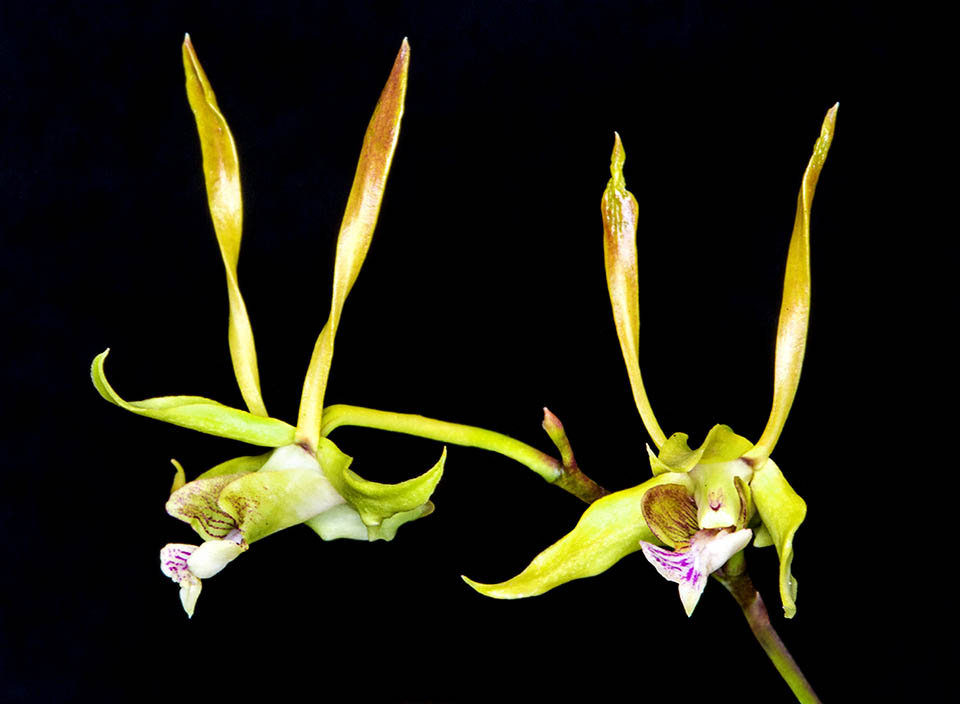
These, about 5 cm wide, are little scented but last 30-40 days. The twisted petals, similar to antelope horns are brownish, whilst sepals are yellow greenish © G. Mazza
Moreover, the petals are twisted up to 2 (or even 3) times and this is a character found also in Dendrobium antennatum Lindl, creating confusion at times. However, according to some Authors, the grade of torsion of the petals is related with the age of the flower and has no taxonomic relevance.
Dendrobium bicaudatum is a species reported in the Appendix II of the Washington Convention (CITES) that has the aim of protecting the animal and vegetable species under risk of extinction, forbidding their export and detention. In 2019 it has also been inserted in the red list of the International Union for Conservation of Nature (IUCN) in the category of “Least Concern” (LC, Least Concern).
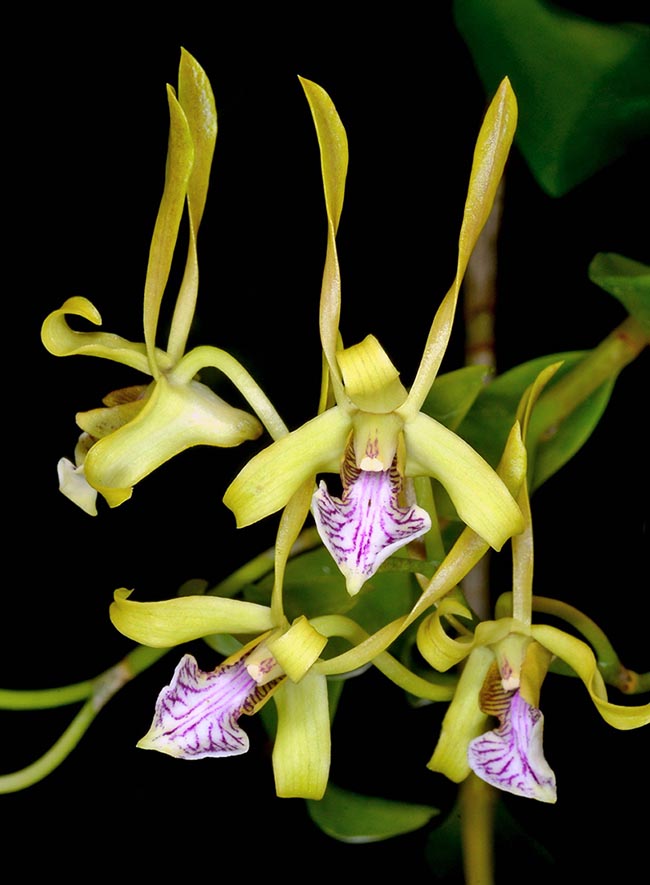
Trilobate labellum, narrowed at apex with triangular lateral lobes and ovate median lobe, is white with reddish veins © Ron Parsons
Nevertheless, in some areas of its habitat, it is under threat of extinction because the local population, during the last years, are cutting down the trees where it lives to produce charcoal.
To hinder this conservation measures are underway in situ and ex situ in order to reduce the risk of extinction of this particular endemism.
Dendrobium bicaudatum is also a fairly ornamental species and of easy cultivation.
It is a plant loving the light, but does not stand the noon time direct rays of the sun.
For a good cultivation it must be kept in mind that in the origin sites the average temperature of the summer days is of 25-26 °C and by night of 21 °C, with a daily difference of 4-6 °C.
In winter, the average temperature of the day is 27-30 °C, and the night one of 16-17 °C with a day difference of 13 °C.
It needs a humidity of about 80-90% all over its growth period, whilst in winter the humidity may be lowered to 65% without exaggerating because the too much dry air causes the yellowing and subsequent drying of the leaves.
Therefore, upon the increase of the temperature, the humidity must be increased, but attention is to be paid to the possible fungine diseases that may originate in a good ventilation is absent.
Dendrobium bicaudatum grows better in wood baskets with a mixed compound of two parts of fern (Osmunda regalis), two of peat and one of fresh sphagnum.
In the bottom is always to be placed a big piece of charcoal that provides ventilation, avoids stagnation and hinders the compound fermentation.
As the pseudobulbs are rather thin, they can be tied to supports such as canes or wires to ensure their stability.
The plant does not love the repotting that will be done only if strictly necessary and after blooming when the new roots begin to take form.
Water must be administered every fortnight and along the whole summer season. When autumn arrives, the quantity of water is to be significantly reduced, but not completely eliminated because the plant might dry out.
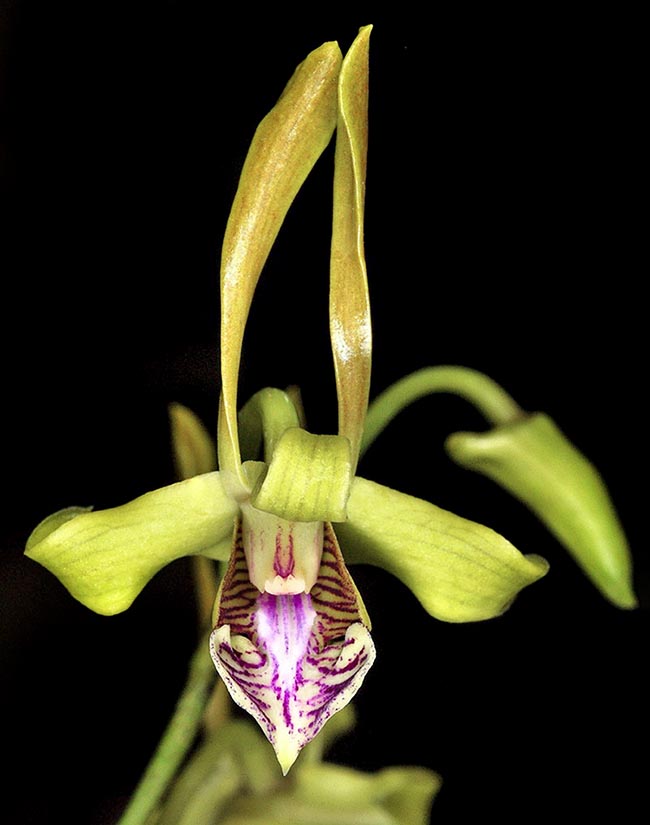
An opening flower. The twisted petals take one week to grow up © Ron Parsons
For the fertilizations it is recommended to use a fertilizer for orchids that is to be administered every seven days with a dosage of 1/4-1/2 the quantity suggested on the package.
A balanced fertilizer can be used throughout the year, but from spring to mid summer it is better to increase the quantity of nitrogen whilst in autumn phosphorus can be increased to stimulate the blooming.
In nature the plant reproduces by seeds but in cultivation it has a low success rate and therefore recourse is done to the symbiotic germination (with in vitro culture techniques) that may be also an alternative solution for its reintroduction in the natural environments.
Dendrobium bicaudatum can reproduce also by division of the tufts upon the vegetative regrowth with each section provided with at least 3-4 pseudobulbs.
Several hybrids exist such as Dendrobium Batavia City obtained from the hybrid Dendrobium Bob Ching × Dendrobium bicaudatum registered in the The International Orchid Register on Aug. 24 2004 by M.H. Cahyanto.
Dendrobium Ayub Parnata, registered in The International Orchid Register on June 2, 2009, obtained by crossing between Dendrobium parnatanum × Dendrobium bicaudatum by A. Parnata on behalf of the Indonesian Ministry of Agriculture (D.G.Hort Indonesia).
Another lovely hybrid is Dendrobium bicaudatum-leporinum proposed in 2018 by crossing between Dendrobium bicaudatum × Dendrobium leporinum).
Among the numerous cultivars that have obtained awards by The American Orchid Society we mention: Dendrobium bicaudatum ‘Vera Cruz’ awarded with the Botanical Recognition Certificate (CBR) in 1998 and Dendrobium bicaudatum ‘Hamlyn’ awarded with the Horticultural Certificate of Merit (CHM) in 2015.
Synonyms: Dendrobium rumphianum Teijsm. & Binn. (1862); Dendrobium burbidgei Rchb.f. (1878); Dendrobium antelope Rchb.f. (1883); Dendrobium minax Rchb.f. (1868); Callista bicaudata (Reinw. ex Lindl.) Kuntze (1891); Dendrobium demmenii J.J.Sm. (1920); Ceratobium bicaudatum (Reinw. ex Lindl.) M.A.Clem. & D.L.Jones (2002); Ceratobium minax (Rchb.f.) M.A.Clem. & D.L.Jones (2002).
